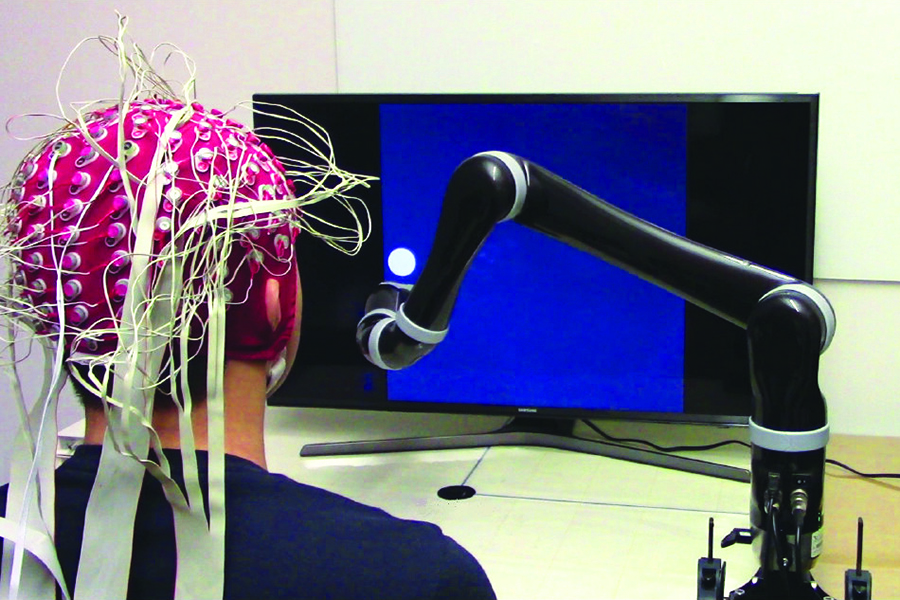Robotic exoskeleton helps patients relearn how to walk
Exoskeletons, once solely fodder for science fiction storylines, are becoming an increasingly common sight in various settings. Hospitals use exoskeletons to help nurses effortlessly lift patients. Wearable robot exoskeletons give factory workers super-human strength. Most recently, Lowe’s home improvement stores started testing exoskeletons to increase the productivity of their warehouse employees while reducing muscle strain.
Robotic exoskeletons are also used in clinical settings as a therapy tool. Inverse reported, “In some advanced facilities, it’s becoming more common for an exoskeleton to be used as people rehabilitate while walking on a treadmill… As robotics become increasingly common in medicine and rehabilitation, it’s important to make sure that the coolest new gadget actually helps people the way it’s supposed to. With the insight provided by these researchers, future exoskeletons and robotic tools can be designed in such a way that better helps the people relying on them to walk again.”
Image Credit: Spaulding Rehabilitation Hospital
Relearning how to walk after neurological damage
The researchers referenced in the Inverse article are a team from Harvard’s Wyss Institute for Biologically Inspired Engineering. Their study, Robot-induced perturbations of human walking reveal a selective generation of motor adaptation, looked at robot-assisted gait therapy.
Learning to walk again after a stroke or a traumatic brain injury is difficult. The central nervous system (CNS) needs to relearn how to communicate with a patient’s legs. As part of this process, a rehabilitation robot can be useful. The rehabilitation robot applies forces to the patient’s legs while holding the torso in place, causing the patient to modify their walking patterns. The goal of the therapy is to help the patient regain their balance and gait, but professionals noted differences in how some patients progressed with such therapies.
For this study, the group of scientists led by Paolo Bonato, Ph.D., director of the Motion Analysis Laboratory at Spaulding Rehabilitation Hospital, used high-tech medical robots and recorded participants’ physiological responses to the way the robot moved their legs. They reprogrammed a therapy exoskeleton to change the length and/or height of the step and monitored how the patients responded.
Our CNS is designed to help us avoid falls. This isn’t a huge surprise since this protects us from the sprains, strains, and breaks that can accompany a stumble. Movements that don’t threaten our balance are less likely to cause the same physiological response. And that is what the study data showed: When the robot changed the center of gravity of the participant, the participant’s CNS automatically tried to move the leg to regain balance. If their balance wasn’t threatened, the response was minimized and the participant didn’t adjust their step.
“Lifting your foot higher mid-stride doesn’t really make you that much less stable, whereas placing your foot closer or further away from your center of mass can really throw off your balance, so the body adjusts much more readily to that disturbance,” says Giacomo Severini, Ph.D., Assistant Professor at University College Dublin and one of the authors of the paper.

Schematic representation of the effects of the mechanical perturbations generated by the robot used in the study. Image Credit: Wyss Institute.
Robot therapy is reliant upon the physiological response to retrain motor skills. If therapists want to retrain a patient to step higher, the robot should be adjusted to make the increase in step height corresponding to a shift in balance. Basically, in order to help the patient relearn to walk, the robot has to make the patient feel like they are about to stumble.
“To modify step height, for example, you’d need to design forces so that the change in height, which the brain normally interprets as neutral, becomes challenging to the patient’s balance,” continues Severini.
MATLAB used throughout the study
A Lokomat therapy robot was reprogrammed with Simulink to enable the changes in stride length and height. The robot was controlled by Simulink models running on a PC running Simulink Real-Time.
The kinematics and kinetic data recorded from the device, as well as the different parameters from the control panel, were post-processed using a MATLAB object-based structure for the initial analysis. This included data segmentation, filtering, and estimation of speeds and accelerations. Further processing made use of fitting tools and the Statistics and Machine Learning Toolbox to estimate the adaptation parameters and their statistical significance.
Additional links you may find interesting:
- From CNN, “These Lowe’s employees are now wearing exoskeletons to work”
- “Robotic Exoskeletons Are Changing Lives in Surprising Ways,” NBC News.
- Wired, “Watch Panasonic’s power-lifting exoskeletons in action”
- “This $40,000 Robotic Exoskeleton Lets the Paralyzed Walk,” MIT Technology Review
 Cleve’s Corner: Cleve Moler on Mathematics and Computing
Cleve’s Corner: Cleve Moler on Mathematics and Computing The MATLAB Blog
The MATLAB Blog Guy on Simulink
Guy on Simulink MATLAB Community
MATLAB Community Artificial Intelligence
Artificial Intelligence Developer Zone
Developer Zone Stuart’s MATLAB Videos
Stuart’s MATLAB Videos Behind the Headlines
Behind the Headlines File Exchange Pick of the Week
File Exchange Pick of the Week Hans on IoT
Hans on IoT Student Lounge
Student Lounge MATLAB ユーザーコミュニティー
MATLAB ユーザーコミュニティー Startups, Accelerators, & Entrepreneurs
Startups, Accelerators, & Entrepreneurs Autonomous Systems
Autonomous Systems Quantitative Finance
Quantitative Finance MATLAB Graphics and App Building
MATLAB Graphics and App Building









Comments
To leave a comment, please click here to sign in to your MathWorks Account or create a new one.